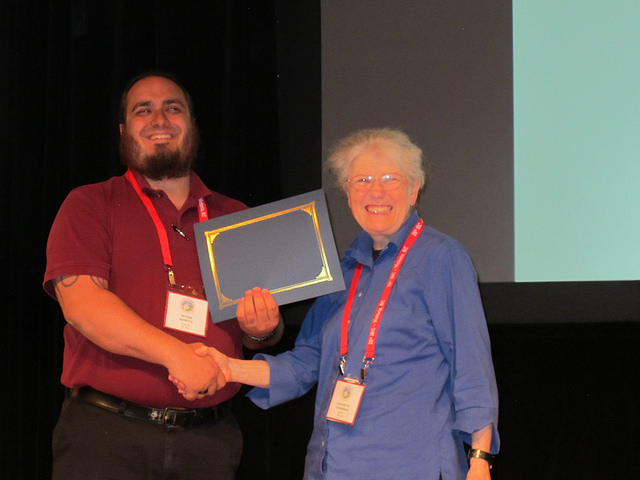The International Biometric Society (IBS) held the 28th International Biometric Conference 10-15 July, 2016 in Victoria, British Columbia, Canada. I had submitted my some of my dissertation work to this conference and gave an oral presentation: Parsimonious B-spline Regression Models via Control Polygon Reduction. The talk was well received. The International Biometric Society presented me with the Best Student Oral Presentation and the Western North American Region (WNAR) of the IBS, which held its annual meeting in conjunction with the conference, awarded me Distinguished Oral Presentation as part of the student paper competition.
These award announcements were also printed in the Biometic Bulletin, vol 33. no. 3 July-September 2016.
Below, I am shaking hands with IBS President Elizabeth Thompson after being
awarded Best Student Oral Presentation.

Abstract
The following is the abstract for the work I presented.
Parsimonious B-Spline Regression Models via Control Polygon Reduction
Tuesday, July 12, 2016 | 2:00 PM – 2:15 PM | Location: Saanich 1-2 (Level 1) Session WNAR Young Investigators 1 Showcase
Peter DeWitt; Nichole Carlson; Samantha MaWhinney
Biostatistics and Informatics, University of Colorado Denver, Anschutz Medical Campus, Aurora, Colorado, United States
B-spline transformations of continuous predictors are commonly used in regression models to estimate a smooth non-linear relationship with the response. The quality of the regression fit is subject to a knot sequence ξ. Selection of a knot sequence is traditionally achieved by choosing between regression models with a varying number of knots, which are placed at the predictor quantiles. AIC or BIC are then used for model selection. It is well known that AIC and BIC can result in big models (i.e. models with a large number of internal knots). If parsimony, minimizing the number of interior knots n(ξ), is important this approach is not desirable. Our goal is to develop an efficient knot selection algorithm that selects models with smaller n(ξ) without sacrificing goodness of fit.
Instead of focusing on likelihood maximization, we present a knot selection method based on the geometry of the b-spline control polygons (CP). CPs have been used extensively in computer aided graphic design and numeric analysis; primarily for deriving and evaluating B-spline approximations to fit complex shapes measured with little to no noise. Changes in CP provide a useful metric for assessing the influence of a particular knot, which we demonstrate can then be used for smart removal of knots.
Our control polygon reduction (CPR) algorithm starts with a CP based on an initial ξ with large n(ξ) and knot positions on a fine partition of the predictor. Inspired by Lyche and Mørken (1988), we assess the influence of each knot on CP geometry and omit the knot exerting the least-influence on the CP shape. After a knot omission, the model is refit with the coarsened knot vector. The process continues until all internal knots are removed. The final regression model is selected as the model with the smallest n(ξ) such that a single additional knot has negligible effects on CP geometry.
We show that for a wide range of functional shapes, including complex longitudinal hormone data, the CPR algorithm results in a final model with fewer internal knots than models selected via traditional approaches and with negligible differences in the sum of squared residuals. CPR is computationally efficient and provides high quality fits built on low-rank design matrices. The CPR algorithm is an attractive solution for knot selection in a wide range of applications.
A bibtex entry for this abstract:
@inproceedings{dewitt2016parsimonious,
author = {DeWitt, Peter E. and Carlson, Nichole E. and Samantha MaWhinney},
title = {Parsimonious B-spline Regression Models via Control Polygon Reduction},
booktitle = {Abstracts for the XXVIIIth International Biometric Conference},
month = {July},
year = {2016},
organization = {International Biometric Society},
address = {Victoria, British Columbia},
url = {http://www.biometricsociety.org/conference-abstracts/2016/},
isbn = {978-0-9821919-4-1}
}
